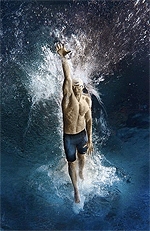Speedo worked with ANSYS — a software company that has helped airliners fly more efficiently and Formula One cars produce more down force — to develop a nylon swimsuit, cap and goggle system that together make up the new Fastskin3 Racing System.
In relation to the projects that ANSYS typically works on, Stephen Silvester, a consultant engineer for ANSYS, told The Engineer: ‘The engineering problem is essentially the same. You have a shape moving through a fluid and we want to make it go through there faster. Outside the engineering community it can be a bit of a leap of the imagination to see that the same technology can work here but the physics and the problems are the same.’

The Fastskin3 Racing System is the successor to Speedo’s LZR Racer suit that forced Fédération Internationale de Natation (FINA), the international swimming body, to introduce new regulations following the success it had in the 2008 Beijing Olympics.
While the LZR Racer suit offered viscous drag reductions of 3–4 per cent, Speedo has found that by combining the suit, cap and goggles, it can achieve total drag reductions of more than 15 per cent.
In order to achieve such reductions, Speedo focused on pressure drag, which relates to the shape of the swimmer.
‘Speedo is producing swim suits that add a compressing effect and actually change the shape of the body,’ said Silvester.
He explained that in order to help Speedo optimise the human form, ANSYS first of all needed to understand the variability of the human shape.
‘To do that Speedo provided us with a large number of 3D body scans,’ he said. ‘The simulation software allowed us to explore the drag performances of all of these different body scans within a very large design space. So we could run 1,200 simulations very quickly and very easily.
‘We could literally take the body shapes. Apply whatever idea we had to the body shape. The simulation software goes off, computes, does the number crunching and gives us the drag values,’ he added.
Each simulation took several hours to complete on a PC not much more powerful than a home computer.
Computational fluid dynamics tests were done on ANSYS Fluent while structural analysis for the goggles was carried out on ANSYS Mechanical.




Glasgow trial explores AR cues for autonomous road safety
They've ploughed into a few vulnerable road users in the past. Making that less likely will make it spectacularly easy to stop the traffic for...